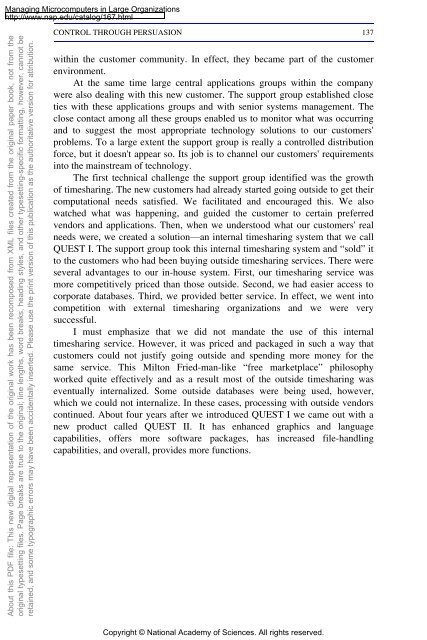Managing Computers in Large Organizations
You also want an ePaper? Increase the reach of your titles
YUMPU automatically turns print PDFs into web optimized ePapers that Google loves.
<strong>Manag<strong>in</strong>g</strong> Microcomputers <strong>in</strong> <strong>Large</strong> <strong>Organizations</strong><br />
http://www.nap.edu/catalog/167.html<br />
About this PDF file: This new digital representation of the orig<strong>in</strong>al work has been recomposed from XML files created from the orig<strong>in</strong>al paper book, not from the<br />
orig<strong>in</strong>al typesett<strong>in</strong>g files. Page breaks are true to the orig<strong>in</strong>al; l<strong>in</strong>e lengths, word breaks, head<strong>in</strong>g styles, and other typesett<strong>in</strong>g-specific formatt<strong>in</strong>g, however, cannot be<br />
reta<strong>in</strong>ed, and some typographic errors may have been accidentally <strong>in</strong>serted. Please use the pr<strong>in</strong>t version of this publication as the authoritative version for attribution.<br />
CONTROL THROUGH PERSUASION 137<br />
with<strong>in</strong> the customer community. In effect, they became part of the customer<br />
environment.<br />
At the same time large central applications groups with<strong>in</strong> the company<br />
were also deal<strong>in</strong>g with this new customer. The support group established close<br />
ties with these applications groups and with senior systems management. The<br />
close contact among all these groups enabled us to monitor what was occurr<strong>in</strong>g<br />
and to suggest the most appropriate technology solutions to our customers'<br />
problems. To a large extent the support group is really a controlled distribution<br />
force, but it doesn't appear so. Its job is to channel our customers' requirements<br />
<strong>in</strong>to the ma<strong>in</strong>stream of technology.<br />
The first technical challenge the support group identified was the growth<br />
of timeshar<strong>in</strong>g. The new customers had already started go<strong>in</strong>g outside to get their<br />
computational needs satisfied. We facilitated and encouraged this. We also<br />
watched what was happen<strong>in</strong>g, and guided the customer to certa<strong>in</strong> preferred<br />
vendors and applications. Then, when we understood what our customers' real<br />
needs were, we created a solution—an <strong>in</strong>ternal timeshar<strong>in</strong>g system that we call<br />
QUEST I. The support group took this <strong>in</strong>ternal timeshar<strong>in</strong>g system and “sold” it<br />
to the customers who had been buy<strong>in</strong>g outside timeshar<strong>in</strong>g services. There were<br />
several advantages to our <strong>in</strong>-house system. First, our timeshar<strong>in</strong>g service was<br />
more competitively priced than those outside. Second, we had easier access to<br />
corporate databases. Third, we provided better service. In effect, we went <strong>in</strong>to<br />
competition with external timeshar<strong>in</strong>g organizations and we were very<br />
successful.<br />
I must emphasize that we did not mandate the use of this <strong>in</strong>ternal<br />
timeshar<strong>in</strong>g service. However, it was priced and packaged <strong>in</strong> such a way that<br />
customers could not justify go<strong>in</strong>g outside and spend<strong>in</strong>g more money for the<br />
same service. This Milton Fried-man-like “free marketplace” philosophy<br />
worked quite effectively and as a result most of the outside timeshar<strong>in</strong>g was<br />
eventually <strong>in</strong>ternalized. Some outside databases were be<strong>in</strong>g used, however,<br />
which we could not <strong>in</strong>ternalize. In these cases, process<strong>in</strong>g with outside vendors<br />
cont<strong>in</strong>ued. About four years after we <strong>in</strong>troduced QUEST I we came out with a<br />
new product called QUEST II. It has enhanced graphics and language<br />
capabilities, offers more software packages, has <strong>in</strong>creased file-handl<strong>in</strong>g<br />
capabilities, and overall, provides more functions.<br />
Copyright © National Academy of Sciences. All rights reserved.


















